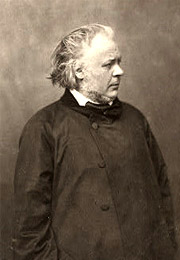


Oil on wood panel
21.9 x 16.5 cm. (8 5/8 x 6 1/2 in.)
frame: 30.5 x 36.0 x 6.5 cm. (12 x 14 3/16 x 2 9/16 in.)
L.1988.62.8
Monsieur Bernard. [Ambroise Vollard (1867–1939), Paris]; sold to Leo Stein (1872–1947) and Gertrude Stein (1874–1946), Paris, 24 Aug. 1904 to ca. 1924 [Durand-Ruel, New York, ca. 1924]. J. M. Price, New York, 1958. Nicholas de Koenigsberg and Charles Mitchell, joint owners, by 29 Jan. 1958; Nicholas de Koenigsberg and Henry Pearlman, joint owners, by 4 Feb. 1958; full interest sold to Henry Pearlman, by 13 May 1960; Henry and Rose Pearlman Foundation, after 1974.
Daumier is most famous for prints satirizing modern life, but another aspect of his talent can be found in his oil paintings, made after government censorship curtailed his printmaking activity. These paintings were little known during his lifetime and this one is a rare treasure in part because it is in such excellent condition. Daumier’s experiments with various oil techniques often proved to be problematic, and many of his other works have become severely compromised over time.
As in his famous, bitingly satirical caricatures, Daumier strove in his paintings not merely to imitate life but also to expose its unpleasant or officially censored aspects. His refusal to idealize the old woman in this portrait can be seen as a critical rejection of romantic or classical styles and an attempt to represent working-class people within the realm of high art.
The verve of Daumier’s brushwork appealed to later collectors, including the author Gertrude Stein, who once owned this painting.
A small painting, Head of an Old Woman, was once offered to me by a dealer who wasn’t sure who had painted it. It looked to me like a Daumier, or possibly a Rembrandt…
A small painting, Head of an Old Woman, was once offered to me by a dealer who wasn’t sure who had painted it. It looked to me like a Daumier, or possibly a Rembrandt, and without knowing for certain, I purchased it. Several months later, while away on vacation, I happened to be reading Art and Appreciation by Leo Stein. In it Stein describes the first painting that he and his sister, Gertrude Stein, bought. It was a little Daumier Head of an Old Woman from Vollard. This was a wry exciting discovery. When I returned to New York a few weeks later, I immediately looked up the various books on Gertrude Stein and found a photograph of the walls of her home, which were completely covered with pictures. There among the pictures on her wall was the portrait I had purchased. It was later exhibited at the Tate Gallery in London, and is now listed in a book by Daumier expert K.E. Maison on his complete works.

Honoré Daumier (1808-1879)
Daumier was a major innovator in the field of political caricature, known for memorable images that used both biting humor and realism to convey urgent social concerns. Through his prints, paintings, and sculptures, Daumier expressed keen sympathy for the plight of the poor and downtrodden, chronicling a period of major social, political, and economic upheaval in mid-19th-century France.
The son of a glazier, Daumier was born in Marseilles and at the age of eight moved to Paris. Economic imperatives led him to work as a bailiff’s assistant by the time he was twelve, instilling in him a disdain for lawyers and a sense of compassion for the impoverished. He developed a passion for drawing and at sixteen trained with Alexandre Lenoir and at the Académie Suisse. Daumier mastered lithography, working for publishers Zéphirin Bélliard and Achille Ricourt, and in 1830 he began to contribute cartoons to the journal Caricature. He developed a vigorous style marked by bold chiaroscuro effects and careful composition. Daumier was an ardent Republican supporter, and his scathing satires combined humor with blunt depictions of abuses of power. In 1832 he was imprisoned briefly for his anti-monarchist caricature of Louis-Philippe as Rabelais’s notorious glutton Gargantua.
As a painter, Daumier was most likely self-taught, beginning to work in oil painting and watercolor for his own pleasure around the mid-1830s. He made copies from paintings by Millet and Rubens and adapted figures from his lithographs into paintings. His subjects ranged from portraiture and scenes of daily life to literature and mythology. Toward the end of his life, Daumier lost his eyesight and died a pauper. His paintings were rarely exhibited during his lifetime, although they gained renown after his death, praised by admirers for their expressive and lively brushwork. Their spontaneous sketch-like quality was even seen by some to presage elements of Impressionism.